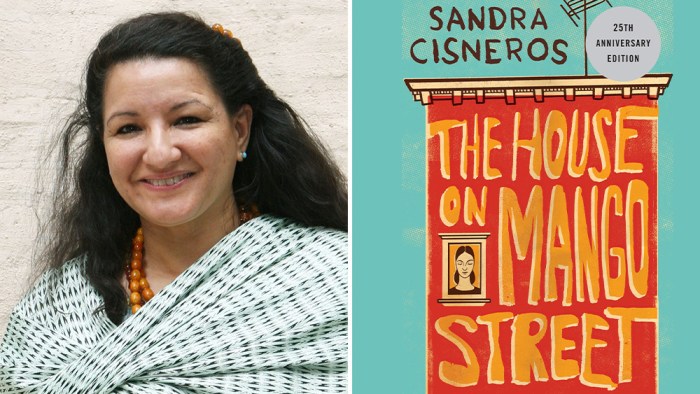Sandra cisneros only daughter pdf – Sandra Cisneros’ “Only Daughter,” a chapter from her celebrated novel The House on Mango Street, invites readers to delve into the profound experiences of Mexican-American women. This analysis explores the chapter’s themes, characters, literary devices, and cultural context, revealing its significance within the novel and its impact on readers.
Esperanza, the chapter’s protagonist, embarks on a journey of self-discovery, navigating the complexities of family, identity, and community. Through her interactions with others, she gains a deeper understanding of her place in the world and the challenges she faces as a young Latina.
Introduction

Sandra Cisneros, a renowned Mexican-American writer, is celebrated for her poignant portrayal of the experiences of women and minorities in her works. Her novel “The House on Mango Street” is a collection of vignettes that explore the complexities of life for a young Latina girl named Esperanza Cordero.
One of the chapters in the novel, “Only Daughter,” holds significant importance as it delves into the themes of identity, family, and the struggles of growing up as a young woman.
Chapter Summary

“Only Daughter” narrates the story of Esperanza’s experiences as the sole daughter in her family. The chapter begins with her feelings of isolation and loneliness, contrasting with the boisterous presence of her four brothers. Esperanza yearns for a sense of belonging and recognition within her family unit, often feeling overshadowed by her brothers’ playful and rambunctious nature.
The chapter also highlights Esperanza’s growing awareness of her gender and the societal expectations placed upon her as a young woman. She observes the traditional roles assigned to women in her family and community, and begins to question her own place within these confines.
As the chapter progresses, Esperanza finds solace in her writing and imagination. She discovers a passion for storytelling and poetry, which becomes an outlet for her to express her thoughts and emotions. Through her writing, Esperanza begins to assert her own identity and voice, breaking free from the limitations imposed by her gender and family.
Themes
Identity and Self-Discovery:“Only Daughter” explores the theme of identity formation as Esperanza grapples with her sense of self and her place within her family and community. Through her experiences and reflections, she begins to understand her own unique qualities and aspirations, defying societal norms and embracing her own individuality.
Family and Relationships:The chapter delves into the complexities of family dynamics and the challenges of growing up in a traditional Mexican-American household. Esperanza’s experiences highlight the tensions between familial love and the limitations imposed by gender roles and expectations.
Gender and Empowerment:“Only Daughter” addresses the theme of gender and the ways in which it shapes Esperanza’s experiences. The chapter exposes the societal constraints and expectations placed upon young women, and Esperanza’s journey of self-discovery and empowerment as she challenges these norms.
Characters
Esperanza Cordero:The protagonist of “Only Daughter,” Esperanza is a young Latina girl who is navigating the complexities of growing up as the sole daughter in her family. She is a thoughtful and imaginative child who yearns for a sense of belonging and recognition.
Through her writing and self-discovery, Esperanza emerges as a strong and resilient character who defies societal norms.
The Family:Esperanza’s family plays a significant role in shaping her experiences. Her four brothers, while loving, often overshadow her, highlighting the gender dynamics within the household. Her parents, while supportive, also perpetuate traditional gender roles, which Esperanza begins to question.
Literary Devices
Symbolism:The house on Mango Street serves as a powerful symbol throughout the novel, representing the constraints and limitations imposed upon Esperanza and her family. The “only daughter” status also symbolizes Esperanza’s unique experiences and struggles as a young woman.
Imagery:Cisneros uses vivid and evocative imagery to create a strong sense of place and atmosphere. The descriptions of the neighborhood, the family home, and Esperanza’s surroundings bring the reader into the world of the novel.
Metaphor:Esperanza’s writing and imagination are metaphorically depicted as a means of escape and self-expression. Through her stories and poems, she finds her voice and breaks free from the confines of her circumstances.
Cultural Context, Sandra cisneros only daughter pdf
Mexican-American Identity:“Only Daughter” is deeply rooted in the experiences and perspectives of Mexican-American women. The chapter reflects the cultural values, traditions, and challenges faced by this community, particularly in terms of gender roles and expectations.
Family and Community:The chapter highlights the importance of family and community within Mexican-American culture. Esperanza’s family provides her with both support and limitations, shaping her sense of identity and belonging.
Social Justice:The chapter touches upon issues of social justice and inequality, particularly in relation to gender and ethnicity. Esperanza’s experiences and reflections expose the ways in which societal norms and expectations can marginalize and limit individuals.
Critical Reception
“Only Daughter” has received critical acclaim for its insightful exploration of identity, family, and gender. Critics have praised Cisneros’s skillful storytelling and her ability to capture the complexities of a young woman’s experiences. The chapter has been recognized for its contribution to the growing body of literature that examines the intersection of race, gender, and class.
However, some critics have argued that the chapter’s focus on gender roles and expectations may be somewhat limited and does not fully explore the broader social and economic factors that shape Esperanza’s life.
Clarifying Questions: Sandra Cisneros Only Daughter Pdf
What is the significance of the chapter “Only Daughter” within The House on Mango Street?
The chapter serves as a pivotal moment in Esperanza’s journey of self-discovery, exploring themes of identity, family, and community.
How does Cisneros use literary devices to enhance the meaning of “Only Daughter”?
She employs symbolism, imagery, and foreshadowing to create a rich and immersive narrative that conveys Esperanza’s experiences and emotions.
What is the cultural context of “Only Daughter”?
The chapter reflects the experiences and perspectives of Mexican-American women, addressing issues of identity, family, and community within a patriarchal society.